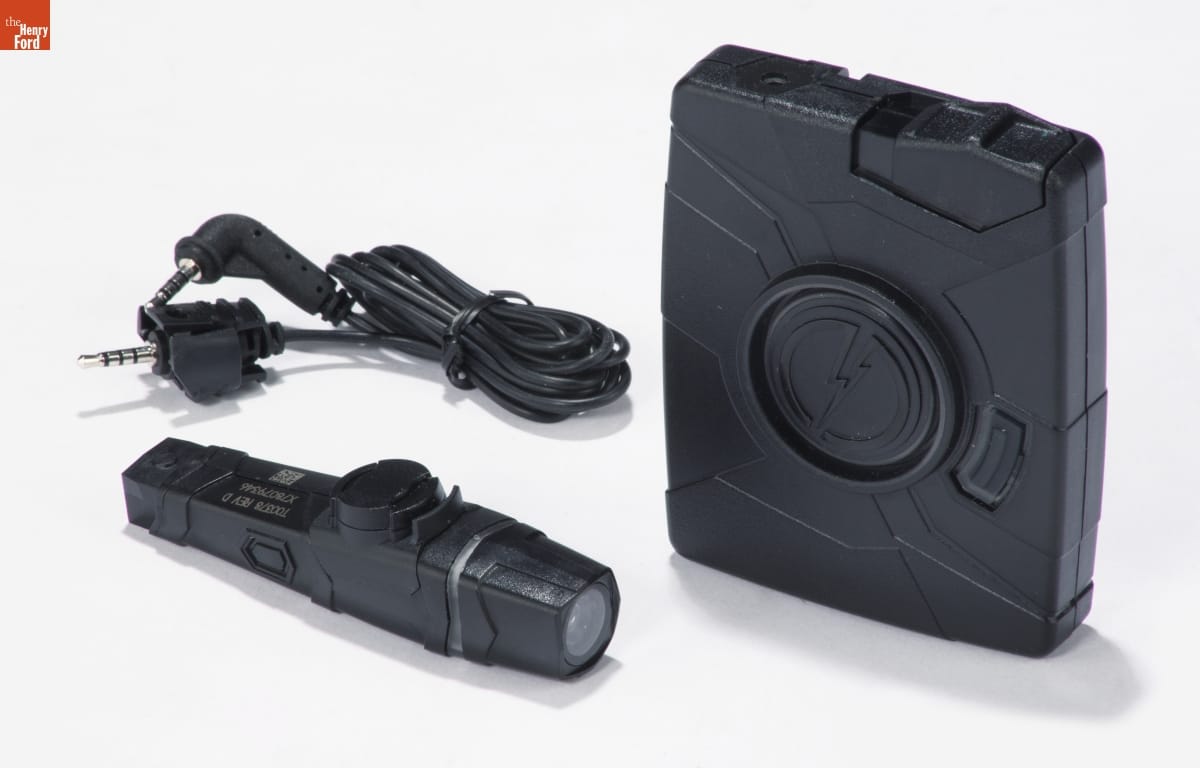
One of the many challenges curators face is collecting our contemporary history—they have to make difficult calls on what objects, clearly important today, will still have an important story to tell future generations. Last fall, Curator of Communication & Information Technology Kristen Gallerneaux accepted a donation of two body cameras designed to be worn by police officers. These cameras as artifacts represent increasing public calls in the 2010s for police transparency and accountability, encouraged in part by the Black Lives Matter movement. They also demonstrate the ways in which technology can be used by law enforcement to gather information. We’ve just digitized both of these Taser Axon cameras, including this 2013 model, making them available via our Digital Collections.
Ellice Engdahl is Digital Collections & Content Manager at The Henry Ford.
21st century, 2010s, technology, digital collections, by Ellice Engdahl

1949 Mercury Convertible, “kustomized” by George and Sam Barris.
Few names loom as large in the world of custom cars as that of George Barris. Mr. Barris, who passed away last November, will forever be associated with the many television and movie cars built by his Los Angeles shop – none more famous than the 1966 Batmobile, adapted from the 1955 Lincoln Futura concept car. But these high-profile cars were just one part of his work. Before Hollywood came knocking, George and his brother Sam had already built a reputation for their imaginative work with other cars, particularly the 1949-1951 Mercury models so loved by first-generation customizers. Indeed, just months before George Barris’s death, several Barris Mercurys were featured at the 2015 Pebble Beach Concours d’Elegance.
We are fortunate to have a Barris Mercury custom – or “kustom,” as Barris invariably spelled it – in the collections of The Henry Ford. Our 1949 Mercury features a chopped windshield; a padded, removable Carson top; frenched headlights and taillights; dechromed surfaces; and prominent “Barris” crests on the front fenders. For a Barris job of the 1950s, the modifications are mild, but sometimes less is more. The color is a deep metalflake purple, with lavender scallops. The scheme continues in the interior, upholstered in purple and white. In the “anything goes” spirit of the custom car hobby, there’s even a little Chevrolet in our Merc – the grille is out of a 1957 Corvette.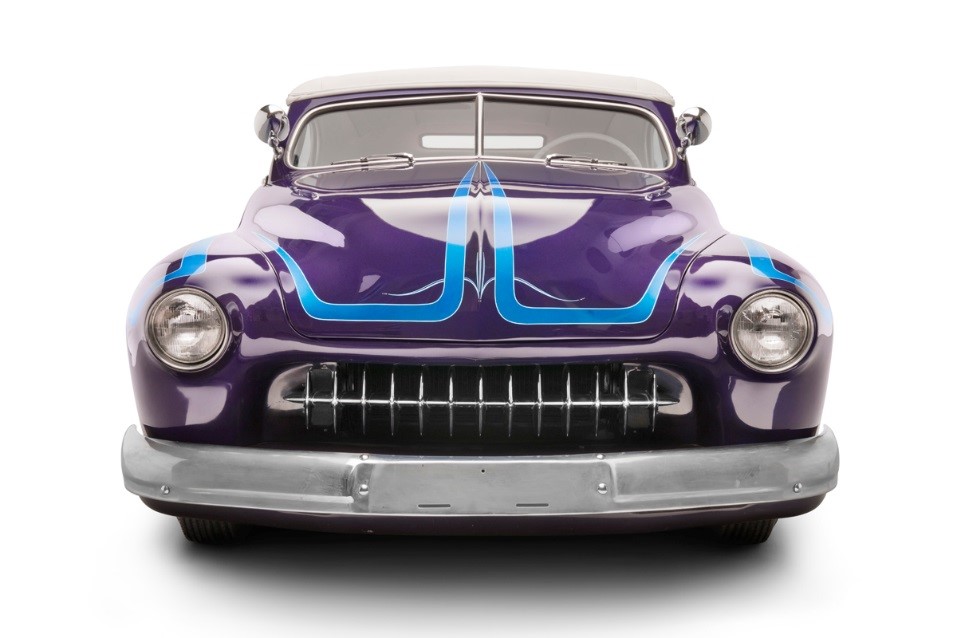
Our Barris ’49 Mercury isn’t all Blue Oval. There’s a bit of Bow Tie in that grille.
The 1949-1951 Mercurys, in stock form, were styled a bit behind the times. Their fenders and small windows looked dated next to other postwar cars – especially alongside their sister 1949 Fords. But those old lines appealed to southern California customizers. Lower the roof and suspension, and you turned a staid sedan into a head-turning – almost intimidating – street machine. Mercury customizers were also fond of removing chrome (famously excessive on production cars of that era), substituting parts from other cars, and applying deep, dark paints to the dramatic bodies. Radical or outlandish modifications hadn’t yet caught on in the field. Customizers essentially tweaked their cars to bring out a natural beauty that they already saw.
Our Mercury, then, is a classic example of these influential custom cars. It’s the perfect symbol for the customizer’s craft in Driving America, and a fitting tribute to one of the best-known “kustomizers” in the business.
Continue ReadingCalifornia, 1950s, 20th century, 1940s, making, convertibles, cars, by Matt Anderson
Thomas Edison, Innovator and Beachcomber
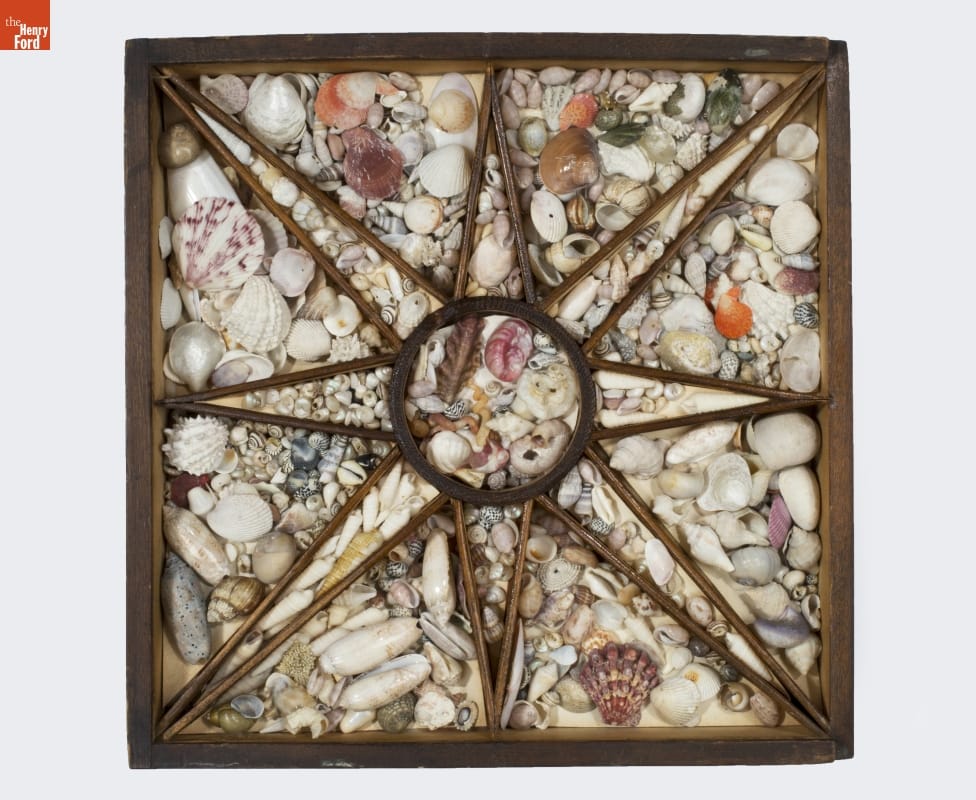
The first object was added to the collections of The Henry Ford over a century ago, years before our official dedication. Artifacts sometimes get overlooked in this large and long-standing collection for periods of time, particularly if they are in storage and have no or minimal digital record of their existence (a problem that digitization of the collection is chipping away at). We were recently combing through our collections database for artifacts related to natural history for an upcoming project, and happened across several items described as “specimen boxes.” A little more investigation revealed they are shadowboxes containing seashells collected by Thomas Edison in Fort Myers, Florida, home to his Ft. Myers Laboratory. We’ve just digitized these shadowboxes, including this star-chambered one—see all three by visiting our Digital Collections.
Ellice Engdahl is Digital Collections & Content Manager at The Henry Ford.
Additional Readings:
- Menlo Park Glass House
- Edison at Work
- First Known Portrait of Thomas Alva Edison, circa 1851
- Edison Talking Dolls
inventors, nature, digital collections, by Ellice Engdahl, Thomas Edison
Protecting Our Presidents
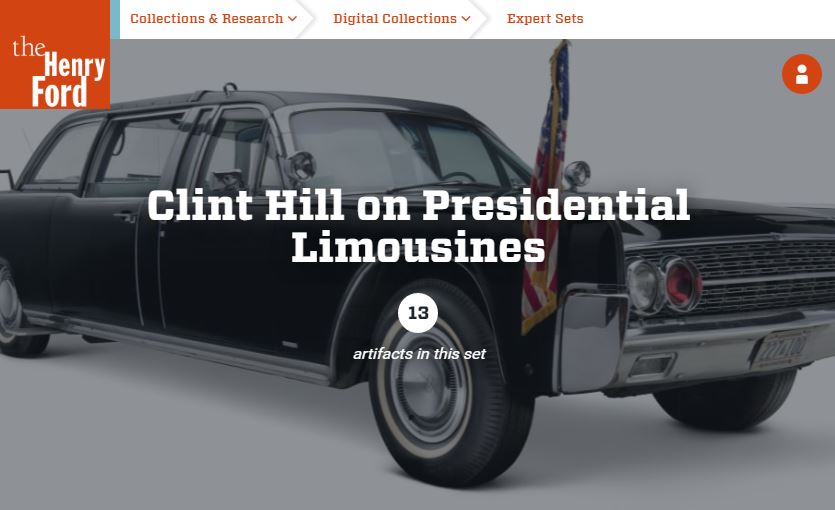
Clint Hill is a former Secret Service agent who was in the presidential motorcade on November 22, 1963, as John F. Kennedy was shot. On May 16, 2016, The Henry Ford will host Mr. Hill, who will talk about his work with five presidents: Eisenhower, Kennedy, Johnson, Nixon, and Ford. While this evening event is sold out, you can still hear some of Mr. Hill’s stories in a video oral history he made at The Henry Ford during an earlier visit in 2013. We’ve just digitized these clips, including one tale of the unusual issues that arise when presidential motorcades are showered with confetti. We’ve gathered all 11 clips in an Expert Set within our Digital Collections for easy viewing.
Additional Readings:
- 1950 Lincoln Presidential Limousine Used by Dwight D. Eisenhower
- John F. Kennedy’s Enduring Legacy
- JFK Remembered: The X-100
- Innovation Icon: Kennedy Presidential Limousine
digital collections, by Ellice Engdahl, JFK, presidential vehicles, presidents
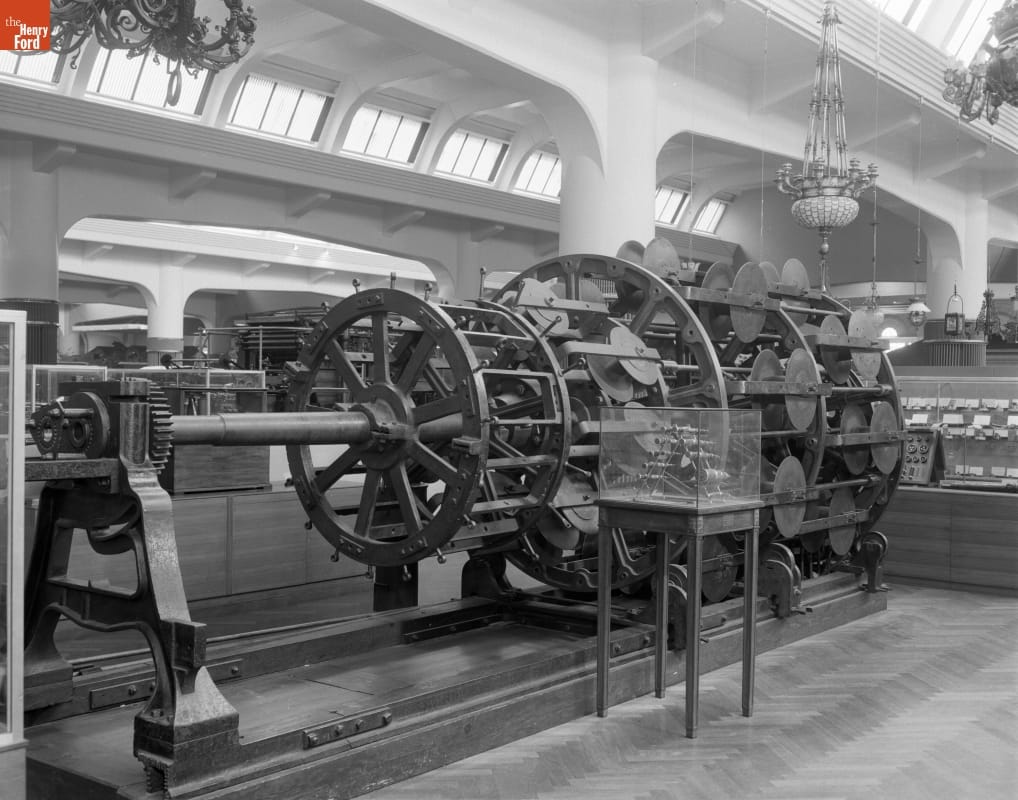
Cyrus Field wanted to wire the world. A successful paper merchant turned telecommunications pioneer, Field established the American Telegraphy Company in 1856 and set to work raising the funds and gathering the minds needed to bridge the oceanic divide between Europe and America.
In 1858, after several failed attempts, an underwater cable—capable of transmitting telegraph signals across the Atlantic Ocean—was laid from Valentia, Ireland, to Heart’s Content, Newfoundland. In August the first messages were sent, including an exchange between Queen Victoria and President Buchanan. It took 17 hours to transmit Queen Victoria’s 98 words. The triumph of the 1858 cable was short-lived; a month later, it failed, a victim of excess voltage in an attempt to increase the speed of messages.
This cable machine, built by Glass, Eliot & Co., was used to prepare telecommunications cable at Enderby’s Wharf in Greenwich, England, for the second transatlantic cable. Machines like these were used to create the core of submarine cable from iron and conductive copper—and then moved aboard a ship, where they applied a protective sheath made of galvanized steel, an insulating layer of gutta-percha and a final layer of jute to protect against abrasion. One mile of finished cable weighed almost a ton, but it was as flexible as a rope, built to withstand the pull of the ship laying it and hazards on the ocean floor.
In 1865, 2,300 nautical miles of cable were carried aboard the leviathan iron steamship, the SS Great Eastern. The ship left in July but was forced to return to port when the cable snapped and the end was lost at sea. A second cable excursion began a year later and was successful. This was the first truly sustainable and durable telegraph cable, continuing to carry the Morse code “text messages” of telegraph operators across continents—at a rate 80 times faster than the first cable. It remained in operation until the mid-1870s, by which time four additional cables had been laid.
This machine was essential to the “wiring of the world,” reorganizing basic materials into the spine of the first permanent transcontinental telecommunications network. These submarine cables—like the modern-day fiber-optic cables that carry the signals of Internet traffic—connected cultures and communities. Continue Reading
1860s, 1850s, 19th century, telegraphy, technology, communication
Mega Robot En Route to The Henry Ford

The Henry Ford always goes big when it comes to hosting Maker Faire Detroit. 2016 promises to be no different. In fact, it might actually go just a bit bigger than ever before.
The call for makers went out at the beginning of April, and the number and scope of innovators answering The Henry Ford's summon didn't disappoint. Visitors to the event can expect some old favorites to be on the scene, such as Maker Works’ Great Maker Race and Cirque Amongus, as well as lots of opportunities to do some hands-on innovating and buy things DIY. But, the big story for Maker Faire 2016 (and we add extra emphasis on the word "big") is the locked-down appearance of MegaBots, said Shauna Wilson, senior manager of National Events for The Henry Ford.
If you're not familiar with MegaBots, they are 15-foot-tall, internally piloted humanoid robots that fire cannonball-sized paintballs at speeds of more than 120 miles per hour. They made quite the media splash last year when they challenged Japan to a robot duel and they accepted. (The date and locale of the historic duel against Kuratas, Japan's 9,000-pound robot, are still to be determined.)
Matt Oehrlein, one of the co-founders of MegaBots and a longtime fan and participant on the Maker Faire circuit, shared a few secrets about what his team will be bringing to Maker Faire Detroit. "Visitors can expect to see the six-ton, 15-foot tall MegaBots Mk. II that challenged Japan to a giant robot duel,” he said, “We'll be testing the weapon system of Mk. II on a scrap vehicle in The Henry Ford's parking lot."
After weapon tests are completed, Oehrlein promises there will be plenty of meet-and-greet ops with the MegaBots team and the Mk. II. "Autographs and group selfies are welcome, too," he added.
The Henry Ford's Wilson and Oehrlein agree that the match up of The Henry Ford, Maker Faire Detroit and MegaBots is a no-brainer. Noted Oehrlein, "The Henry Ford gives a historical look at innovation over time, and we believe MegaBots represents innovation of today. It will be amazing for people to come to Maker Faire Detroit, walk through The Henry Ford and see innovation over the years, and then come outside and witness a six-ton robotic beast representing today's advancements in technology. We are so excited to be a part of this story."
Did You Know? The MegaBot Mk. II made its debut at Maker Faire San Mateo in 2015.
Archaeology's Underground
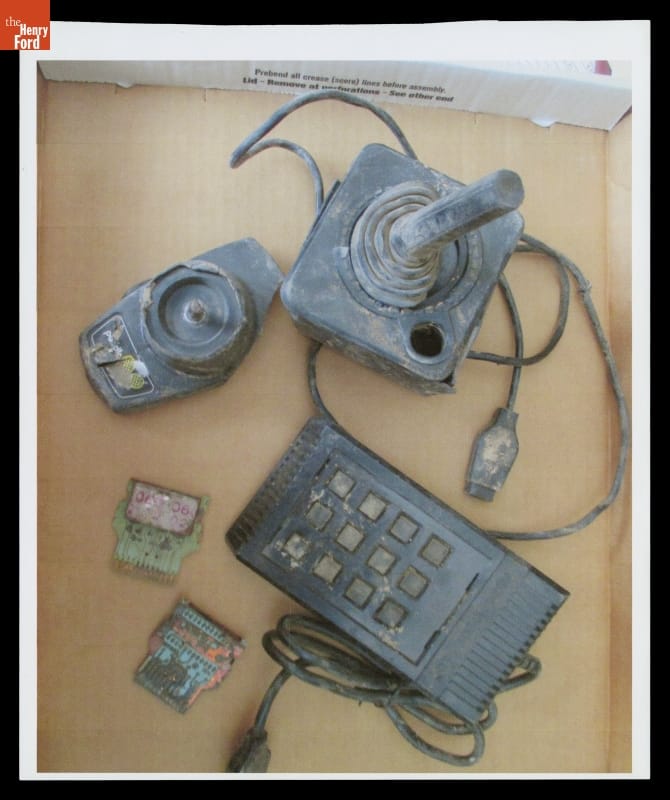
Artifacts Recovered from an Alamogordo, New Mexico Landfill, April 2014, Site of the 1983 Atari Video Game Burial - THF122265
The Strongest Sandstorm of the Year
A 30-foot-deep pit in constant danger of collapsing in on itself. Mercury-laced pig remains. Unexploded World War II ordnance. Poisonous gas. Two years ago, the threats were real in the desert landscape of Alamogordo, New Mexico, as archaeologists prepared to commence an important historical dig.
For video games. In a landfill.
In April 2014, the Atari burial ground of urban legend was excavated and artifacts exhumed to worldwide media acclaim. More important, a global conversation about what archaeology is or should be began. And a new strand of the scientific study of human history, culture and its preservation that had been somewhat underground was given newfound legitimacy. 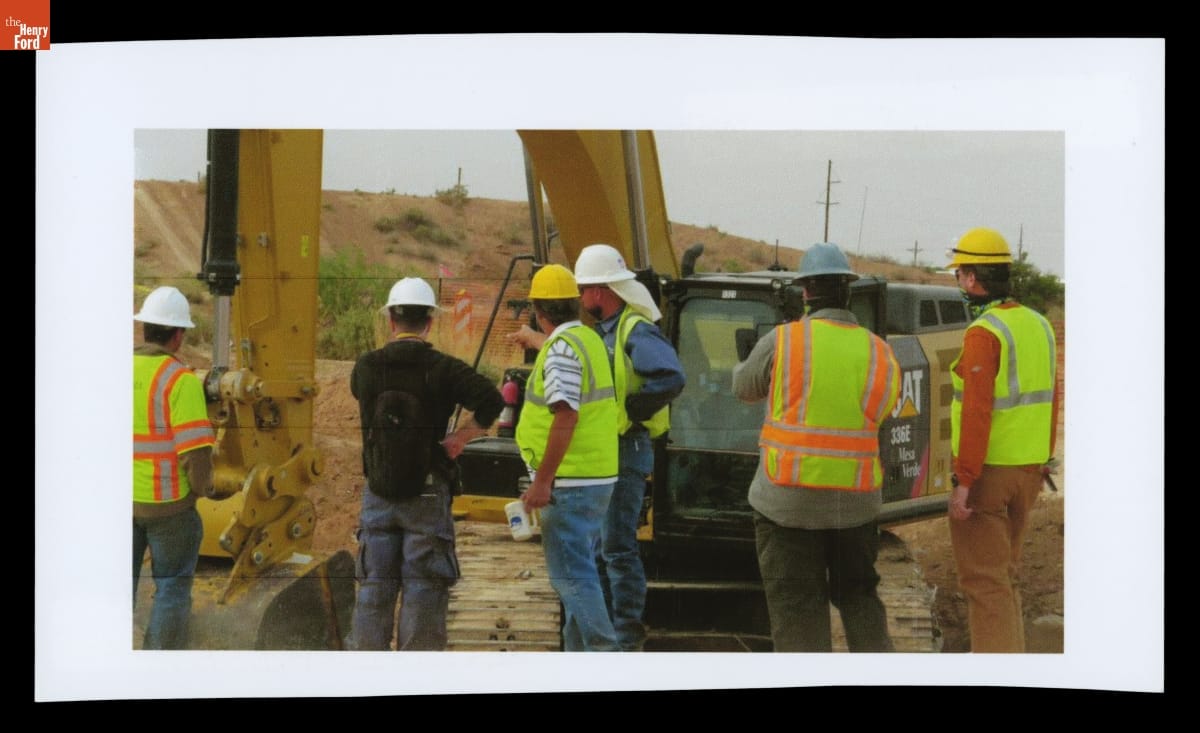
Excavation Crew in April 2014 at the Alamogordo, New Mexico Landfill, Site of the 1983 Atari Video Game Burial - THF122241
Punk Archaeology
Known as “archaeology of the recent past,” punk archaeology is archaeology at the margins, focusing on documenting and preserving histories and cultures thought of by others as either too strange or obscure for serious study. Thriving on a DIY work ethic, volunteerism and community outreach, it bridges the gap between science and instant communication with a curious public.
This movement began in 2008 when two professors of archaeology, Bill Caraher and Kostis Kourelis, started casual conversations about how quite a few Mediterranean archaeologists they knew of also had punk rock associations or predilections. Those chats jump-started a blog, where the two started bantering online about themes shared between punk rock and their own archaeological methods. How punk rock and archaeology share an irreverence of tradition, an interest in abandoned spaces and see value in objects discarded. How they both embrace destruction as part of the creative process. How punk music has archaeological underpinnings in its songs — not in their reproduction of the past necessarily, but in their preservation of the past through brazen critique.
The blog ultimately led to the publication of the book Punk Archaeology, a manifesto of sorts about how we can use punk music as a tool to think about archaeology in different, more playful ways. But like punk, the play is serious and has, at its core, a social conscience.
As a collective study, punk archaeology realizes that as the speed of consumerism and technology continue to increase at such a rapid rate, it threatens to leave no real archaeological record. That by recording the recent past and the artifacts left behind almost as it happens, punk archaeologists can retain information for future use by scholars of culture, technology and even trash. Punk archaeology strives to give a voice to history that can be too easily ignored or forgotten by the mainstream.
The now-infamous Atari excavation marked the first official punk archaeology gig using real archaeological methods for digging, documenting and preserving artifacts less than 50 years old. I was lucky enough to lead the team on the dig, which included Caraher, Richard Rothaus (fearless field director), Raiford Guins (video game historian) and Bret Weber (sociologist).
All of us have one foot in punk history and the other foot in either classical antiquity or the American West. We were willing volunteers, happy to participate in a project that would be a first-of-its-kind technology excavation. All captivated by the weirdness surrounding the story behind it and mindful of how punk embraces the weird and does so on a shoestring.
A Tale of Trash
Urban legend had it that in 1983 video game giant Atari buried millions of copies of its notorious flop, E.T. — The Extra-Terrestrial, in a landfill in the New Mexico desert. Trucked over from Atari’s warehouse in El Paso, Texas, and dumped, the games sat among heaps of trash, subject to nightly thefts by adventurous kids who would sneak in and grab from the pile, until everything was finally driven over with heavy machinery and covered with a slurry of concrete and alternating layers of sand and garbage.
The facts and fiction of the tale had long been debated in certain circles. Some rumors claimed that Atari buried the goods to rid itself of the game thought to have singlehandedly caused the video game crash of the mid-1980s. Others said that the dump never happened. No way could a company as huge as Atari do such a thing.
Years later, online chat rooms still continued to buzz, speculating about the truth of the legendary disposal and cover-up, with some Internet conspiracy theorists claiming that perhaps as many as 5 million games had been buried, still entombed beneath a solid concrete slab.
Finally, 30 years after the supposed event, a film production company secured the rights from the city of Alamogordo to excavate the old landfill as part of the documentary Atari: Game Over on the video game crash. When I learned of this agreement, I wrote to Fuel Entertainment to see how they planned to manage the “archaeology” of the excavation. A few months later, our team was invited to participate.
We reached the Atari level 30 feet underground on April 26, 2014, to the cheers of hundreds of Alamogordo residents, gamers, pop-culture mavens, news media and even the creator of the E.T. video game, Howard Scott Warshaw. Copies of more than 40 Atari games, plus Atari 2600 consoles and controllers, were excavated, some still boxed, in shrink wrap or with price tags from Target and Wal-Mart on them.
So a legend was proven true. But what about the archaeology? And what should be done with the artifacts recovered and the stories they held?
As we examined the recovered games, we spoke to the crowd and to the media. Traditional archaeological digs and excavations rarely have public onlookers, but we welcomed the audience, sharing what we found. Punk archaeology is public archaeology. And while the Internet usually takes a passing interest in archaeological projects, typically leaving any news of discoveries to professional journals and books, this was different. The excavation of the Atari burial ground trended globally on Twitter and Facebook, prompting a public debate as to what archaeology is.
For all of us on-site in New Mexico, the excavation yielded artifacts from our recent past that had been discarded as trash — considered artifacts now because they represent a culture, a heritage for people of a certain age. They are a statement to the corporate culture and mindset of a time. 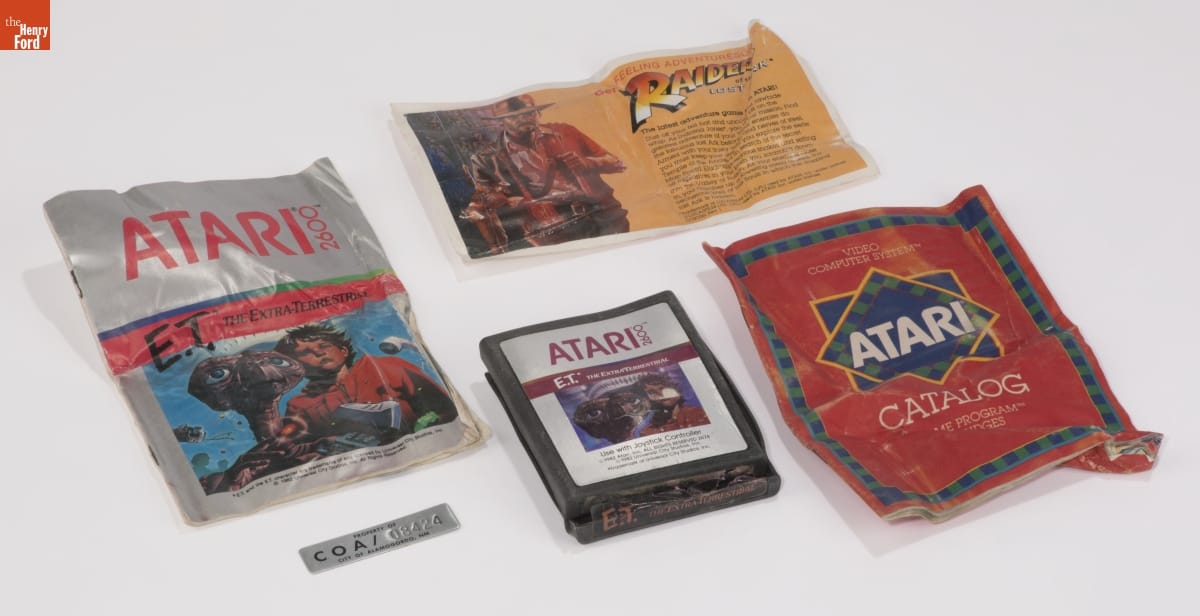
E.T. the Extra-Terrestrial," Recovered from Landfill, Alamogordo, New Mexico, April 26, 2014, Site of the Atari Video Game Burial of 1983- THF159970
And now, they are recognized for their significance by the likes of institutions such as The Henry Ford, the Smithsonian Institution, the Strong Museum of Play and the Vigamus video game museum, all of which accepted items recovered from the Atari burial ground as part of their collections — once again giving further legitimacy to the legend, the dig and the recovered items as important artifacts in the study of 1980s pop culture and human history.
Continue Reading
technology, toys and games, video games, The Henry Ford Magazine, by Andrew Reinhard
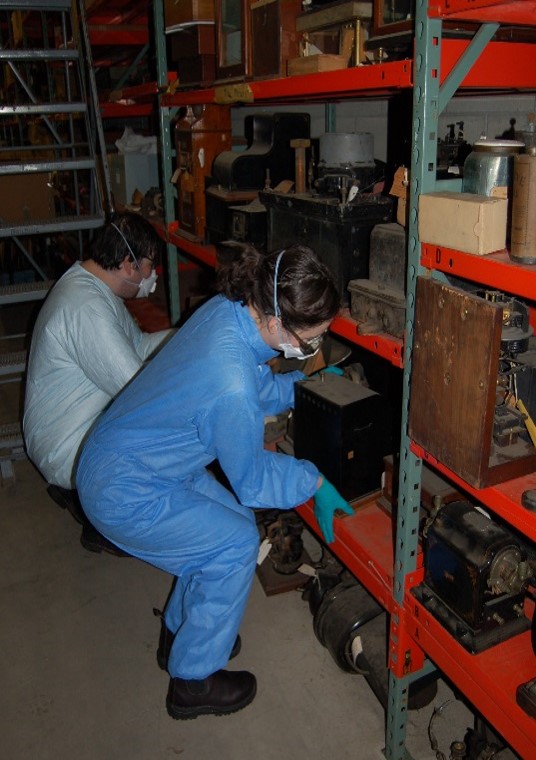
Conservation specialist Mallory Bower and collections specialist Jake Hildebrandt removing objects from shelving in the Collections Storage Building. The Henry Ford has recently embarked on a new adventure, thanks to a grant from the Institute of Museum and Library Services (IMLS) which allows us to spend time working on the electrical collections currently housed in the Collections Storage Building. This is The Henry Ford’s second IMLS grant dedicated to improving the storage of and access to collections. The first grant focused on communications technology, and was completed over two years, ending in October 2015. At the end of that grant, more than 1000 communications-related objects were conserved, catalogued, digitized, and stored, marking a huge improvement in the state of the collections and their accessibility. We have similar goals for this grant, as we aim to complete 900+ objects by October 2017.
The Henry Ford has recently embarked on a new adventure, thanks to a grant from the Institute of Museum and Library Services (IMLS) which allows us to spend time working on the electrical collections currently housed in the Collections Storage Building. This is The Henry Ford’s second IMLS grant dedicated to improving the storage of and access to collections. The first grant focused on communications technology, and was completed over two years, ending in October 2015. At the end of that grant, more than 1000 communications-related objects were conserved, catalogued, digitized, and stored, marking a huge improvement in the state of the collections and their accessibility. We have similar goals for this grant, as we aim to complete 900+ objects by October 2017.
digitization, electricity, power, by Louise Stewart Beck, conservation, collections care, IMLS grant, #Behind The Scenes @ The Henry Ford
Ford Motor Company’s First Home
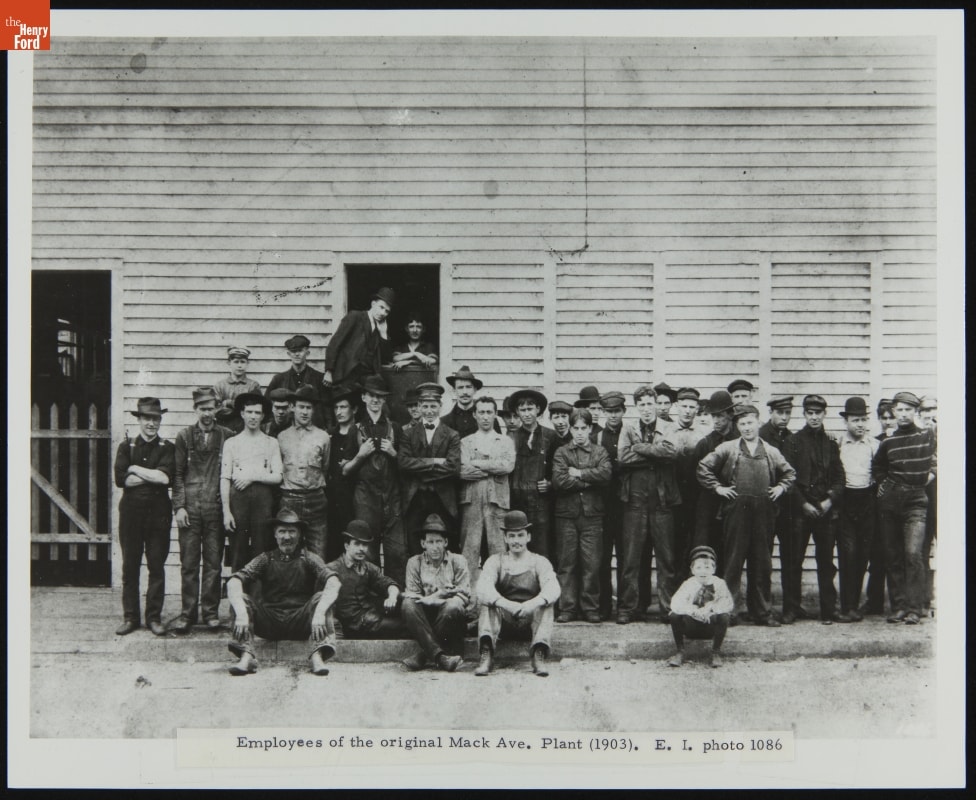
The first Ford Motor Company vehicle ever produced was made at the company’s first factory, located on Mack Avenue in Detroit. The Mack Avenue Plant is so significant to Ford history that it was reproduced, at a smaller scale, in Greenfield Village in 1945. We’ve just digitized a few images related to the original Mack Avenue Plant, including this 1903 photograph of plant employees. Visit our Digital Collections to see more artifacts related to Mack Avenue.
Ellice Engdahl is Digital Collections & Content Manager at The Henry Ford.
Greenfield Village buildings, Greenfield Village, Ford Motor Company, digital collections, by Ellice Engdahl
Sparking Innovation: Apple 1
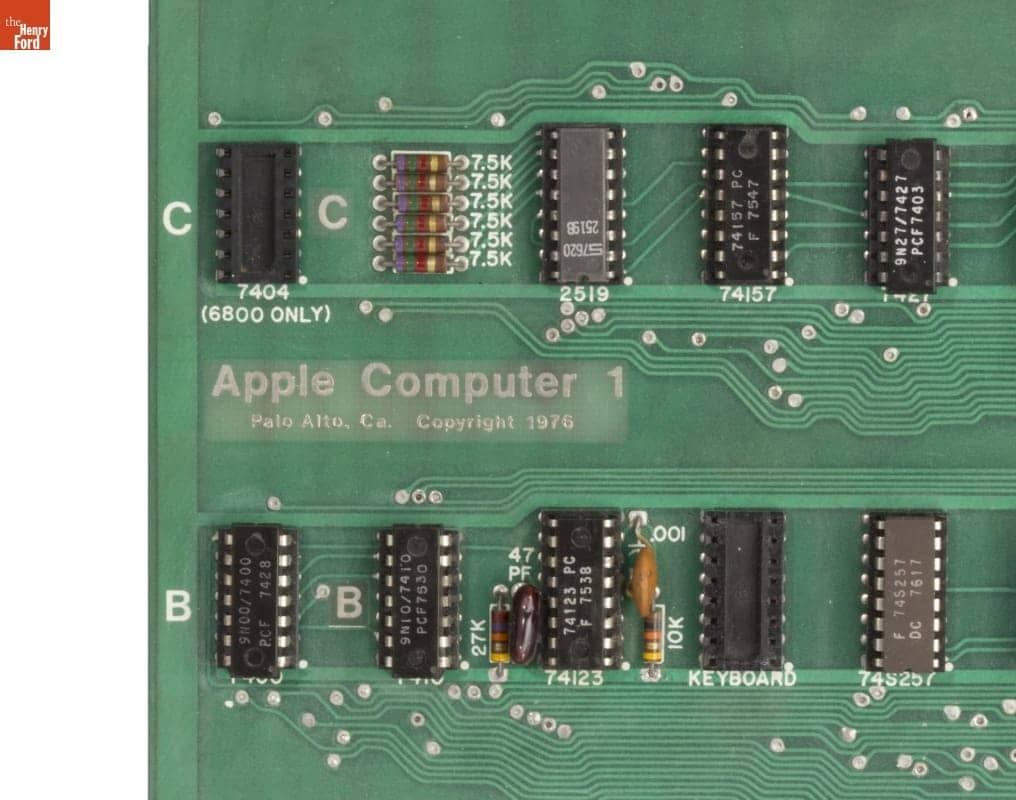
“Nobody'd ever imagined it, a full computer that could run programs could be that small.” — Steve Wozniak
How did a meeting in a garage provide the inspiration for a new king of home computing?
On a rainy day in March 1975, some of the most radical minds in computing gathered in the garage of Gordon French in Menlo Park, California. At this—the inaugural meeting of the Homebrew Computer Club—technical genius and countercultural ethics fused with the obsession to push technology to its limits for social good. It made for an inspiring (if not competitive) environment. Steve Wozniak, then an engineer working at Hewlett-Packard, had been given a flyer for that first Homebrew meeting by a co-worker. He attended and walked away with the inspiration to create an affordable and powerful computer for the everyday home user. This was the beginning of the Apple 1.
Wozniak wanted to provide the maximum amount of computing power using the least amount of components. Thanks to the powerful new 6502 MOS microprocessor chip, he found a way to condense his design onto a small rectangular circuit board holding a total of 60 chips. He also gave some thought to a user-friendly interface. The Apple 1 is the first personal computer that allowed people to type on a keyboard and have their text show up on a television monitor.
In 1976, Wozniak’s engineering skills, coupled with his friend Steve Jobs’ bold marketing moves, led to an order for 200 assembled Apple 1 motherboards by ByteShop owner Paul Terrell. And the word assembled here is important—the Apple 1 is the first preassembled personal computer ever sold. Before the Apple 1, computer enthusiasts built their systems from kits, soldering components and pairing them with clunky interface components like teletype machines. Wozniak later reminisced: “Nobody'd ever imagined it, a full computer that could run programs could be that small.”
Ironically, when it came time to find the money to produce the circuit boards for the first Apple 1 order, Wozniak’s contribution was raised by selling his HP-65 calculator, a follow-up model to the HP-35. When the Apple 1 circuit boards arrived, they were assembled and tested over the course of 30 days at the Jobs family home. This was the humble, almost cottage-industry-like beginnings of what would become one of the world’s most profitable companies. When Wozniak and Jobs took their first order, they had no way of predicting what the future would bring.
 From our Archive of American Innovation to your living room. Take home a piece of history when you give today. Your support will spark innovation among future change makers. Donate $150 or more and receive a limited-edition, signed and numbered museum-quality print (while supplies last).
From our Archive of American Innovation to your living room. Take home a piece of history when you give today. Your support will spark innovation among future change makers. Donate $150 or more and receive a limited-edition, signed and numbered museum-quality print (while supplies last).
Inspired by the Apple 1A breakthrough in manufacturing invented by Apple Inc. Captured by internationally renowned photographer Lisa Spindler, 12" x 12," unframed.
Learn more about Apple 1:

